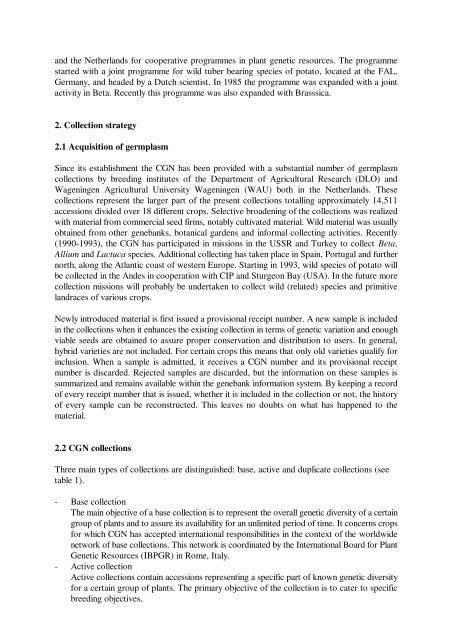Integration of Conservation Strategies of Plant Genetic ... - Genres
Integration of Conservation Strategies of Plant Genetic ... - Genres
Integration of Conservation Strategies of Plant Genetic ... - Genres
You also want an ePaper? Increase the reach of your titles
YUMPU automatically turns print PDFs into web optimized ePapers that Google loves.
and the Netherlands for cooperative programmes in plant genetic resources. The programme<br />
started with a joint programme for wild tuber bearing species <strong>of</strong> potato, located at the FAL,<br />
Germany, and headed by a Dutch scientist. In 1985 the programme was expanded with a joint<br />
activity in Beta. Recently this programme was also expanded with Brasssica.<br />
2. Collection strategy<br />
2.1 Acquisition <strong>of</strong> germplasm<br />
Since its establishment the CGN has been provided with a substantial number <strong>of</strong> germplasm<br />
collections by breeding institutes <strong>of</strong> the Department <strong>of</strong> Agricultural Research (DLO) and<br />
Wageningen Agricultural University Wageningen (WAU) both in the Netherlands. These<br />
collections represent the larger part <strong>of</strong> the present collections totalling approximately 14,511<br />
accessions divided over 18 different crops. Selective broadening <strong>of</strong> the collections was realized<br />
with material from commercial seed firms, notably cultivated material. Wild material was usually<br />
obtained from other genebanks, botanical gardens and informal collecting activities. Recently<br />
(1990-1993), the CGN has participated in missions in the USSR and Turkey to collect Beta,<br />
Allium and Lactuca species. Additional collecting has taken place in Spain, Portugal and further<br />
north, along the Atlantic coast <strong>of</strong> western Europe. Starting in 1993, wild species <strong>of</strong> potato will<br />
be collected in the Andes in cooperation with CIP and Sturgeon Bay (USA). In the future more<br />
collection missions will probably be undertaken to collect wild (related) species and primitive<br />
landraces <strong>of</strong> various crops.<br />
Newly introduced material is first issued a provisional receipt number. A new sample is included<br />
in the collections when it enhances the existing collection in terms <strong>of</strong> genetic variation and enough<br />
viable seeds are obtained to assure proper conservation and distribution to users. In general,<br />
hybrid varieties are not included. For certain crops this means that only old varieties qualify for<br />
inclusion. When a sample is admitted, it receives a CGN number and its provisional receipt<br />
number is discarded. Rejected samples are discarded, but the information on these samples is<br />
summarized and remains available within the genebank information system. By keeping a record<br />
<strong>of</strong> every receipt number that is issued, whether it is included in the collection or not, the history<br />
<strong>of</strong> every sample can be reconstructed. This leaves no doubts on what has happened to the<br />
material.<br />
2.2 CGN collections<br />
Three main types <strong>of</strong> collections are distinguished: base, active and duplicate collections (see<br />
table 1).<br />
- Base collection<br />
The main objective <strong>of</strong> a base collection is to represent the overall genetic diversity <strong>of</strong> a certain<br />
group <strong>of</strong> plants and to assure its availability for an unlimited period <strong>of</strong> time. It concerns crops<br />
for which CGN has accepted international responsibilities in the context <strong>of</strong> the worldwide<br />
network <strong>of</strong> base collections. This network is coordinated by the International Board for <strong>Plant</strong><br />
<strong>Genetic</strong> Resources (IBPGR) in Rome, Italy.<br />
- Active collection<br />
Active collections contain accessions representing a specific part <strong>of</strong> known genetic diversity<br />
for a certain group <strong>of</strong> plants. The primary objective <strong>of</strong> the collection is to cater to specific<br />
breeding objectives.










